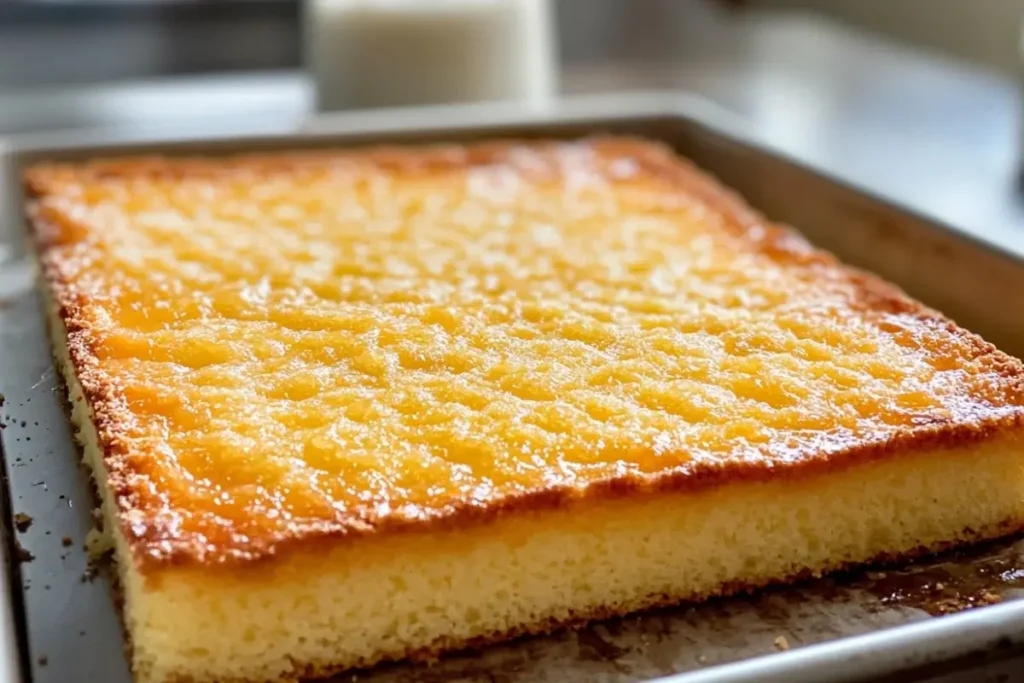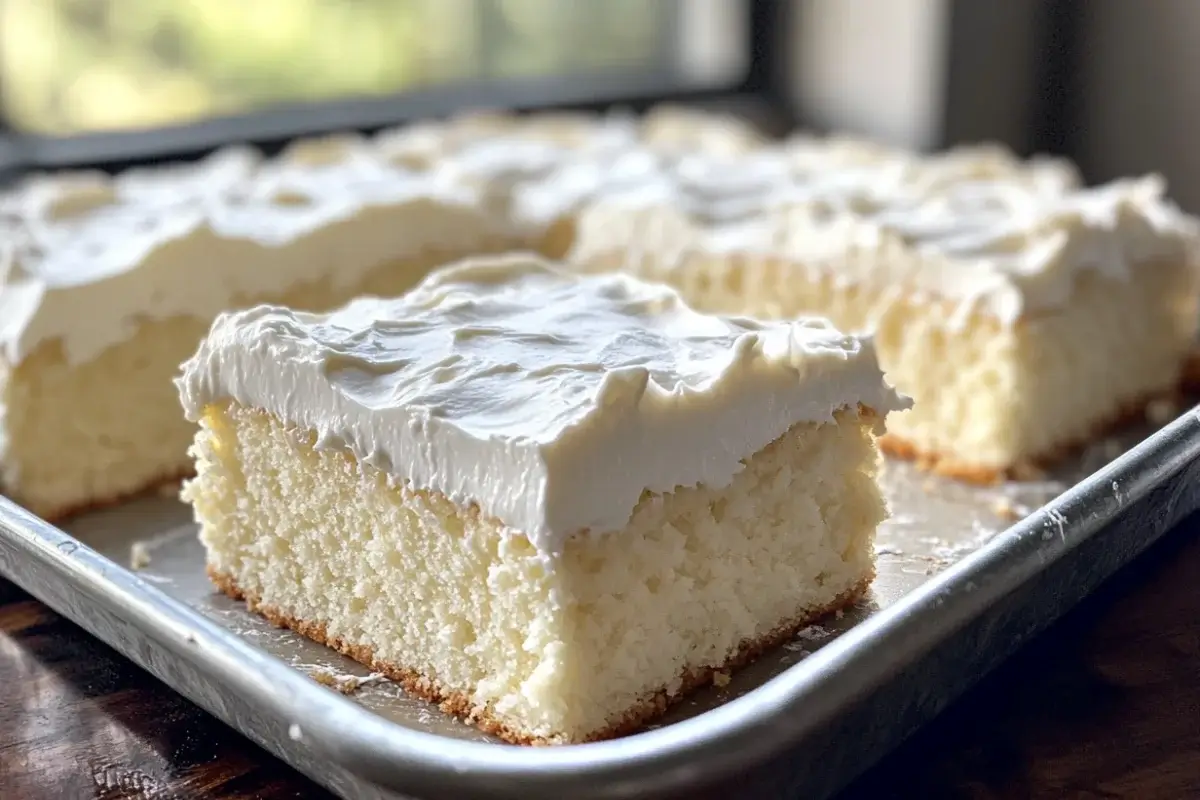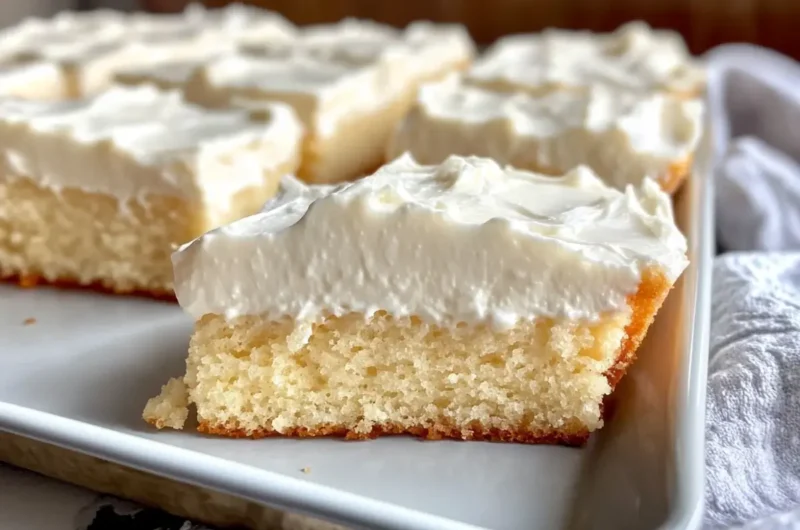Last Updated on May 9, 2025 by Souhail
If you’ve never tried a kefir sheet cake recipe, you’re in for a treat! This easy, fuss-free dessert bakes up soft, fluffy, and perfectly moist thanks to the magic of kefir. The tangy flavor of this probiotic-rich ingredient adds a lovely depth that balances the sweetness, making each bite feel just a little extra special.
Perfect for potlucks, birthdays, or a cozy weekend bake, this sheet cake is as versatile as it is delicious. You can keep it simple with a dusting of powdered sugar or dress it up with your favorite frosting and toppings. However you serve it, this kefir sheet cake is sure to earn a permanent spot in your recipe box.
Table of contents
Why This Recipe Works
There are countless sheet cake recipes out there, but this kefir sheet cake recipe stands apart for several reasons:
1. Moisture and Texture
The kefir in this recipe works magic on the texture of the cake. Its natural acidity tenderizes the gluten in the flour, resulting in a soft, almost velvety crumb. Unlike cakes that risk becoming dry after a day or two, this cake retains its moisture beautifully, thanks to the kefir.
2. Tangy Flavor Profile
The tang from the kefir balances out the sweetness of the cake, creating a more nuanced flavor profile. It’s a refreshing departure from overly sugary desserts.
3. Ease of Preparation
This recipe is beginner-friendly. It doesn’t require advanced baking techniques or hard-to-find ingredients. Everything comes together in one bowl, making cleanup a breeze.
4. Customizable for Different Tastes
Want a chocolate version? Replace some of the flour with cocoa powder. Prefer a citrusy twist? Add lemon or orange zest. This cake is incredibly adaptable, making it perfect for experimentation.
5. Healthier Twist
Kefir isn’t just tasty, it’s also packed with probiotics and nutrients. While this is still a dessert, the inclusion of kefir gives it a slight nutritional edge over traditional sheet cakes.
6. Perfect for Any Occasion
This sheet cake is incredibly versatile. Dress it up with cream cheese frosting for a fancy celebration or keep it simple with a dusting of powdered sugar for a casual snack. Either way, it’s a guaranteed crowd-pleaser.
Customization Options
- Dairy-Free: Substitute kefir with a plant-based yogurt or a mix of almond milk and a splash of apple cider vinegar.
- Gluten-Free: Use a 1:1 gluten-free flour blend for an equally delicious result.
- Add-Ins: Incorporate nuts, dried fruit, or even chocolate chips for added texture and flavor.
Ingredients Breakdown
Here’s what you’ll need to make this delectable kefir sheet cake. Gather these ingredients, and you’ll be ready to bake:
For the Cake:
- All-Purpose Flour – 2 ½ cups (315 g)
- The base of the cake, providing structure. For a lighter texture, sift the flour before measuring.
- Granulated Sugar – 1 ½ cups (300 g)
- Balances the tang of the kefir while adding sweetness.
- Baking Powder – 2 teaspoons
- Ensures the cake rises evenly, giving it that beautiful fluffiness.
- Baking Soda – ½ teaspoon
- Reacts with the acidity of the kefir for an extra tender crumb.
- Salt – ½ teaspoon
- Enhances the flavors of the other ingredients.
- Unsalted Butter – ½ cup (113 g), melted and cooled
- Adds richness and moisture to the cake.
- Eggs – 3 large
- For structure and a soft, airy texture.
- Kefir – 1 cup (240 ml)
- The star ingredient! Use plain, unsweetened kefir for the best results.
- Vanilla Extract – 1 teaspoon
- Adds warmth and depth to the cake’s flavor.
Optional Additions:
- Zest of 1 Lemon or Orange – For a citrusy twist.
- Chopped Nuts or Chocolate Chips – About ½ cup, folded into the batter.
For the Frosting (Optional):
- Cream Cheese – 8 oz (227 g), softened
- Powdered Sugar – 1 ½ cups (180 g), sifted
- Vanilla Extract – 1 teaspoon
- Milk or Heavy Cream – 2-3 tablespoons, to adjust the consistency
Step-by-Step Instructions

First Step: Prep the Oven and Pan (5 minutes)
- Preheat your oven to 350°F (175°C).
- Grease a 9×13-inch sheet pan with butter or cooking spray, and line the bottom with parchment paper for easy removal.
Second Step: Combine Dry Ingredients (5 minutes)
- In a large mixing bowl, whisk together the flour, sugar, baking powder, baking soda, and salt.
- Ensure the ingredients are well blended to avoid clumps in the batter.
Step 3: Mix Wet Ingredients (5 minutes)
- In another bowl, whisk together the melted butter, eggs, kefir, and vanilla extract until smooth.
- If adding citrus zest, stir it into this mixture.
Step 4: Combine Wet and Dry Ingredients (5 minutes)
- Gradually add the wet ingredients to the dry ingredients.
- Use a spatula or a wooden spoon to mix until just combined don’t overmix! Overworking the batter can lead to a dense cake.
Fifth Step: Pour and Bake (35-40 minutes)
- Pour the batter into the prepared sheet pan, spreading it evenly with a spatula.
- Bake in the preheated oven for 35-40 minutes or until a toothpick inserted in the center comes out clean.
- Remove the cake from the oven and let it cool in the pan for 10 minutes, then transfer to a wire rack to cool completely.
Step 6: Prepare the Frosting (Optional, 10 minutes)
- Beat the cream cheese until smooth.
- Gradually add the powdered sugar, then mix in the vanilla extract.
- Add milk or cream one tablespoon at a time to achieve your desired consistency.
Last Step: Frost and Decorate (Optional, 5 minutes)
- Spread the frosting over the cooled cake using an offset spatula.
- Garnish with a sprinkle of lemon zest, nuts, or shredded coconut for added flair.
Pro Tips for Success
To ensure your kefir sheet cake Recipe turns out perfect every time, follow these expert tips:
1. Measure Accurately
- Use a kitchen scale for precise measurements, especially for flour. Too much flour can make the cake dense.
2. Room Temperature Ingredients
- Bring your eggs, kefir, and butter to room temperature before mixing. This helps the ingredients combine more smoothly, creating a uniform batter.
3. Don’t Overmix
- Mix the batter until just combined. Overmixing can lead to a tough texture.
4. Rotate the Pan
- For even baking, rotate the sheet pan halfway through the baking time.
5. Cool Completely Before Frosting
- A warm cake will cause the frosting to melt and slide off, so be patient!
6. Storage Tips for Freshness
- Store the cake in an airtight container at room temperature for up to two days, or refrigerate for up to a week.
Variants of Kefir Sheet Cake Recipe
This recipe is incredibly versatile, allowing you to tailor it to your preferences. Here are some exciting variants to try:
1. Chocolate Kefir Sheet Cake
Replace ½ cup of the flour with unsweetened cocoa powder to create a decadent chocolate version. Add a handful of chocolate chips for extra indulgence. Pair it with a chocolate ganache or whipped cream for a luscious dessert.
2. Lemon Poppy Seed Kefir Sheet Cake
Add 1 tablespoon of lemon zest and 2 tablespoons of poppy seeds to the batter. Top with a tangy lemon glaze made from powdered sugar, lemon juice, and a hint of vanilla. This variant is perfect for spring gatherings or tea time.
3. Coconut Kefir Sheet Cake
Replace ½ cup of the flour with finely shredded coconut. You can also sprinkle toasted coconut flakes on top of the cream cheese frosting for a tropical twist.
4. Berry Swirl Kefir Sheet Cake
Swirl ½ cup of your favorite berry jam (such as raspberry or blueberry) into the batter before baking. This creates a visually stunning cake with bursts of fruity flavor in every bite.
5. Spiced Kefir Sheet Cake
Add 1 teaspoon of ground cinnamon and ¼ teaspoon each of nutmeg and allspice to the dry ingredients. This cozy variant pairs beautifully with a caramel drizzle or cream cheese frosting.
6. Gluten-Free Kefir Sheet Cake
Substitute the all-purpose flour with a gluten-free 1:1 baking blend. Ensure your baking powder and soda are gluten-free as well. The texture and flavor remain just as delightful.
Serving Suggestions
Enhance the experience of enjoying your kefir sheet cake with these serving ideas:
1. Classic and Simple
- Dust the cooled cake with powdered sugar for a minimalist approach. This is perfect for when you want a quick snack or a lighter dessert.
2. Layered Elegance
- Slice the sheet cake in half horizontally, spread a layer of fruit preserves or whipped cream between the layers, and frost the top. This transforms the humble sheet cake into a showstopper.
3. Pair with Fresh Fruits
- Serve slices of the cake with a side of fresh berries, such as strawberries, blueberries, or raspberries. Their natural tartness complements the tangy kefir beautifully.
4. Ice Cream Combo
- Warm a slice of the cake slightly and top it with a scoop of vanilla or berry ice cream. The combination of warm cake and cold ice cream is irresistible.
5. Drizzle Delight
- Drizzle the cake with a simple glaze made from powdered sugar, a splash of kefir, and vanilla extract. Or try a caramel or chocolate sauce for added decadence.
6. Festive Garnishes
- Sprinkle the frosted cake with colorful sprinkles, edible flowers, or candied nuts for a celebration-worthy presentation.
Storage and Reheating Instructions
Proper storage ensures your kefir sheet cake remains fresh and delicious for days.
Storage Tips:
- Room Temperature:
- If unfrosted, store the cake in an airtight container at room temperature for up to 2 days.
- Frosted cake should be covered and refrigerated to maintain freshness.
- Refrigeration:
- Place the cake in an airtight container and store it in the refrigerator for up to 7 days. This is ideal for cakes with cream cheese frosting or other perishable toppings.
- Freezing:
- For longer storage, freeze the cake. Wrap it tightly in plastic wrap, then aluminum foil, and place it in a freezer-safe bag. It can be frozen for up to 3 months. Thaw it in the refrigerator overnight before serving.
Reheating Instructions:
- For Unfrosted Cake:
- Warm individual slices in the microwave for 10-15 seconds.
- Alternatively, reheat the cake in a 300°F (150°C) oven for 5-10 minutes for a freshly baked feel.
- For Frosted Cake:
- Allow the cake to come to room temperature before serving. Avoid reheating in the microwave to prevent the frosting from melting.
Kefir Sheet Cake Recipe Card
FAQ of Kefir Sheet Cake Recipe
Yes, you can substitute kefir with Greek yogurt. Use the same quantity (1 cup) and thin it with 2-3 tablespoons of milk for a similar consistency.
This could be due to overmixing the batter, which develops too much gluten. Make sure to mix the wet and dry ingredients until just combined.
Absolutely! Use a 1:1 gluten-free baking blend. Ensure your baking powder and soda are also gluten-free.
Insert a toothpick into the center of the cake. If it comes out clean or with a few crumbs, the cake is done. Avoid overbaking, as this can make the cake dry.
Yes! Wrap the cooled, unfrosted cake tightly in plastic wrap and aluminum foil, then freeze for up to 3 months. Thaw overnight in the fridge and frost before serving.
Many lactose-intolerant people can tolerate kefir due to its fermentation process, which reduces lactose. However, opt for dairy-free kefir if needed.
Other Uses for Kefir in Baking
Kefir isn’t just a healthful drink—it’s a powerhouse ingredient that can elevate your baked goods in surprising ways. Its natural acidity and creamy texture make it a versatile substitute for a range of dairy products. Whether you’re out of yogurt, buttermilk, or milk, kefir can step in without compromising the taste or texture of your recipes. Here’s how you can use kefir as a substitute in various baking scenarios:
1. Can I use kefir instead of yogurt in cake?
Yes, you can use kefir instead of yogurt in cake recipes. Kefir has a thinner consistency than yogurt but offers a similar tangy flavor, making it a great substitute. If the recipe relies on the thickness of yogurt for structure, you may need to reduce other liquids slightly to maintain the right batter consistency. Start by replacing yogurt with an equal amount of kefir and adjust as needed.
2. Can I use kefir instead of buttermilk in cake?
Absolutely! Kefir is an excellent substitute for buttermilk in cake recipes. Both are acidic and provide a tangy flavor that reacts with baking soda or baking powder to help your cake rise. Use an equal amount of kefir to replace buttermilk in any recipe. Since kefir is often slightly thicker than buttermilk, you may need to whisk it briefly to loosen it up before measuring.
3. Can I use kefir instead of milk in muffins?
Yes, kefir can be used instead of milk in muffin recipes, and it adds extra moisture and a slight tang to the final product. Because kefir is thicker and more acidic than milk, it may create a denser muffin with a soft crumb. To balance this, consider increasing the leavening agents slightly (e.g., add ¼ teaspoon more baking soda) to ensure a good rise. Use an equal amount of kefir as a direct substitute for milk.
Final Thoughts
The kefir sheet cake Recipe is more than just a dessert, it’s a testament to the magic of simple ingredients coming together to create something extraordinary. With its moist texture, tangy flavor, and versatility, this cake is bound to become a favorite in your baking repertoire. Whether you keep it plain, frost it with creamy perfection, or customize it with add-ins and toppings, it’s a recipe that suits every occasion and palate.
The beauty of this cake lies in its adaptability. You can experiment with flavors, tweak the ingredients to fit dietary needs, or even transform it into new creations like trifles or muffins. And thanks to kefir’s unique properties, you’re not just baking something delicious, you’re crafting a cake with an added touch of healthful goodness.
I encourage you to give this recipe a try and let it become a staple in your kitchen. Your friends and family will love it, and you’ll love how easy and rewarding it is to make. If you enjoyed this recipe, don’t forget to explore other delightful baking ideas on the blog!
Have fun baking, and remember, every great cake starts with a sprinkle of creativity and a dash of love.


